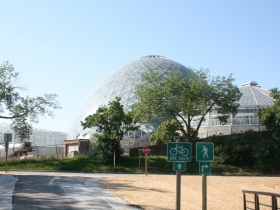“Think Big!” Domes Task Force Is Told
Consultant hired by county offers bold new vision for the domes and Mitchell Park.
Milwaukee County has contracted with a consultant based out of Montana to help the Mitchell Park Domes Task Force plan their final recommendation. And they’re getting pushed to do something big.
The task force has until the beginning of August to provide the Milwaukee County Board with a recommendation for how to move forward with the domes. And the resounding message from the board is that they will not accept anything less that repairing and restoring the domes. So with that in mind the consulting group ArtsMarket, Inc., under the leadership of Louise Stevens, along with her husband and co-principal, John Stevens, is telling the task force they need to need to focus on the final goal.
Stevens told the task force last week that the domes, if they are to be repaired, need sustainability. And sustainability means revenue. And revenue means more engagement from the public than the domes currently get. And more engagement means creating an entirely new experience at the domes. Think big, to save the domes, Stevens told them. This way of thinking follows the Stevens’ axiom: “Begin with the end in mind.”
In their first presentation, the Stevens envisioned a future for the domes that will take a decade or more to realize, and will be considerably more involved than just repairing and restoring the domes. The general proposal from ArtsMarket is to create a business plan, not only for the domes, but for Mitchell Park as a whole: “We feel that making the domes successful, means making Mitchell Park successful.”
This business plan, the Stevens’ hope, would make the domes sustainable for at least the next 50 years, and would act as a 10-year comprehensive plan for Mitchell Park. The general thrust of their proposal envisions a new approach to collections and exhibits within the domes, one that maintains the domes’ educational mission. The plan would activate much more space within Mitchell Park and possibly include events space and a food service option, potentially a restaurant.
Their general pitch to the task force preserves Mitchell Park as a park, and the domes are still the domes. But it brings the exhibits and revenue options into the 21st century. The domes were built in the 1960s and “Leaving a lasting impression today, we know, is a very different business that it was then,” the consultants note.
The domes need new ways to generate revenue if they’re going to last. ArtsMarket is not the first to note this. The audit conducted by the county’s Office of the Comptroller noted that an outsize portion of their revenue, more than 80 percent, is from admission. This means that the only way for the domes to realize new revenue is through changes in admission practices. And if admission at the domes goes way up, it becomes a public asset in name only.
So ArtsMarket wants to revamp programming, to generate repeat visitors, even members, at the domes. They would like to see more space within Mitchell Park activated, in a way that meshes with the mission of the domes. In fact, ArtsMarket believes Mitchell Park should be envisioned as an urban-horticultural destination.
In their work, ArtsMarket is drawing from examples around the country where local governments have turned around failing horticultural institutions. Event space and a food service, ArtsMarket believes, are important pieces.“Food and weddings, we can’t say it enough. It is an economic engine. When do people connect with culture. It’s at weddings and it’s around the table,” Stevens said.
And concerning the current programming, the static exhibits in the domes are an enterprise that fail to generate the types of visitor the domes need. Stevens used examples of touring exhibits to engage repeat visitors. They would work just like the visiting exhibits at the Milwaukee Art Museum. And once Milwaukee County has state-of-the-art horticultural facilities, the county could someday produce its own exhibit that it sells to other conservatories around the country, thereby generating revenue.
ArtsMarket recommends a phased plan, one that takes ten years or more to complete. But even so, the sticking point is money. How does Milwaukee County fund all this? The key to this proposal is partnerships: Public-Private partnerships that will attract investment in the domes and Mitchell Park. Also, tax credits. Stevens mention Historic Preservation, PACE, Opportunity Zone and New Market Tax Credits. Though, to use many of these, there would likely need to be a new ownership structure in place, in lieu of strict County Parks ownership. It could be a memorandum of understanding or a a lease share. All of that, along with the scope of investment and programmatic change, is still to be determined.
Guy Smith, Parks Department Director, said, “We’re gonna have to think big on this one. Obviously funding is a big thing. But I like the fact that we’re looking at a lot of different funding opportunities.”
All of which involves a complete rethinking of the domes. The Stevens think the best way for Milwaukee County to save the domes is to create a cultural destination that continues to engage visitors in new ways for years beyond the bonding schedule for structural repairs. And the domes, as they currently stand, are a far cry from that vision.
The Domes
If you think stories like this are important, become a member of Urban Milwaukee and help support real independent journalism. Plus you get some cool added benefits, all detailed here.
MKE County
-
J.D. Vance Plays Up Working Class Roots, Populist Politics in RNC Speech
 Jul 17th, 2024 by Graham Kilmer
Jul 17th, 2024 by Graham Kilmer
-
Ron Johnson Says Free-Market Principles Could Fix Education
 Jul 17th, 2024 by Graham Kilmer
Jul 17th, 2024 by Graham Kilmer
-
RNC Will Cause Some County Services To Be Moved to Wauwatosa
 Jul 12th, 2024 by Graham Kilmer
Jul 12th, 2024 by Graham Kilmer


























